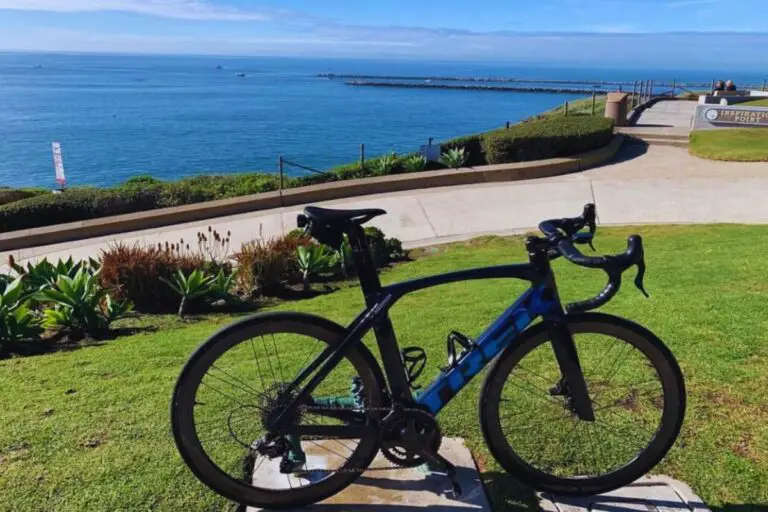Last year, I reached a point where I was training hard every day. I knew I shouldn’t be. I knew it wasn’t helping my performance, but I couldn’t stop.
I also didn’t know how I should be spending the days I’m not training – are recovery rides or rest days better?
It’s an interesting debate, right?
Let’s find out more…!
What Is A Cycling Recovery Ride?
A recovery ride is considered a ride you would do after a tough or long day in the saddle. The idea of a recovery ride is to ride at an easy pace for around 60 – 90 minutes.
Stick to Zones 1 and 2 during this ride. However, I lean more towards Zone 1.
It’s essential to give your muscles some gentle exercise. By keeping the heart rate and effort low, you can enhance your recovery without adding additional stress to your body.
The Importance Of A Recovery Ride
A recovery ride can help promote blood flow, help the muscles repair, and aid in removing metabolic waste products.
While rest days have their place, remaining stationary after a challenging ride can cause your muscles to tighten and cramp up.
Not taking a recovery ride can hurt your performance and progress as a rider. It’s one of the reasons why cyclists can experience a plateau in their performance.
Failing to recover after a long ride can also lead to illness and overtraining. Not only does it impact you physically, but it also affects you mentally.
You start to lose your ‘freshness,’ and (believe it or not) you get sick of training.
I know I have woken up feeling unmotivated to return to the bike after taking a day off. Doing enough to keep your body moving but recovering can be critical to your training efforts and motivation levels.
It can also prevent waking up feeling like I have!

When Should You Do A Recovery Ride?
This does depend on how often you’re cycling and the nature of your rides. I’d suggest a recovery ride around twice a week.
Let’s say you do two or three days of big rides (or a single ride if it’s a huge effort), then take a recovery ride.
Another thing to be mindful of is when you set out on a big ride, and you’re pushing too hard, you’re too tired to keep going at that pace.
Tone it down! Listen to your body. It can prevent you from overtraining. Turn it into a recovery ride.
At the end of the day, if you push your body too hard, it will resist. Be that an injury or slowing your training progress down, you aren’t going to see a benefit to taking it too hard.
Want some tips as to how to take a recovery ride? Here you go!
How Long Should A Recovery Ride Be?
I said earlier that a recovery ride should be between 60 – 90 minutes, and that’s a pretty good guide (even if I say so myself!).
However, it does come down to how often you ride and what type of ride you’re recovering from.
Ideally, you want your legs spinning more than you would normally. This is a point I struggle with, although, over time, I am seeing the benefit, so I recommend it!
Hills are where it can be easy to forget you’re supposed to take it easy. Without thinking, you can find your heart rate going up, and bam, you’re in zone 2 or 3, which isn’t where you should be!
Take hills slowly, and focus on spinning as easily as you can.
One way I discipline myself is by keeping myself in the small ring. It forces me to spin when I wouldn’t usually. Try to find flat routes for recovery rides and somewhere with little traffic.
Personally, I’d highly recommend choosing a route with a good coffee shop on the way round. It is not just for the coffee and cake but also keeps the ride relaxed.
Mental Recovery: It’s All in the Head
Ever had those days when physically, you feel like you could pedal to the moon and back, but mentally, you’re just not “in the zone“? That’s because your mind, like your body, needs recovery time.
Cycling, while liberating, can also be intense, especially if you’re pushing your limits regularly. It’s crucial to give your grey matter some downtime. Mental fatigue can be just as debilitating as physical exhaustion.
Consider activities that can refresh you mentally. Maybe it’s reading a book, meditating, or watching Netflix on a lazy afternoon. The key is to find something that makes you feel relaxed and disconnected from the pressures of training.
It’s also okay to step back from cycling now and then. If you start to feel like rides are becoming a chore rather than a joy, it might be a signal from your brain asking for a break. Listen to it!
After a mental breather, you’ll likely feel recharged, re-energized, and ready to return to the saddle with a newfound zeal.
Remember, mental miles matter just as much as physical ones. So, take care of that noggin!
The Importance Of Rest Days For Cyclists
Riding a bike can be addictive. When it becomes a part of your routine, it can be challenging to know when to stop. I know I’ve been guilty of this.
I learned that rest days are just as important and can help improve your performance.
Training super-hard consistently will stress your body and break down your muscles. A rest day can repair all of this and leave your muscles stronger than they were.
A rest day can leave you feeling fitter and more able to produce more sustained power on your bike. It sounds great, doesn’t it?

Should You Take Rest Days From Cycling?
Absolutely!
Nobody can sustain an effort of giving everything at work all day, every day, can they? You burn out. You become unproductive and less effective, and you don’t get a chance to recover.
It’s precisely the same principle as riding a bike. Your body needs time to repair.
If you think of training as a process. You break your body down, and over time, you rebuild it. The rebuilding part is vital, but that doesn’t happen until your body rests. So without rest, your body can’t rebuild!
Your glycogen levels will be depleted after a tough day in the saddle. Resting gives you a chance to top these up. Getting your energy levels back up to where they started from can take around 36 – 48 hours if you’ve seriously pushed yourself.
The fibers in your muscles will have become damaged and broken down during exercise. Resting and proper nutrition allow them to knit themselves back together and be stronger.
How Many Rest Days Should A Cyclist Take Each Week?
How much time you need to take off will depend on you – your body should tell you what it needs.
A pro athlete can do up to seven days of intensive training and not suffer. Unfortunately, I do not fall into that category and take two days off a week!
This strikes up a good balance for physical and mental recovery. It can also become relatively easy to let cycling dominate your life, and two days off helps it from doing so.
Two days off may seem like a lot to some people, but you will find that those days you train will become more intense and effective.
Rest days must be just that. Restful. No heading to the gym or running around the block. Feet up and relax!
Signs You Need A Rest Day
Overtraining Syndrome (OTS) is when our body takes on more damage than it can repair. Cyclists often tread a fine line between being at their peak and overtraining.
It can be easy to fall into overtraining. You are recovering, and finding your form after this can be a long process, so it’s best to be aware of the signs and take preventive action.
Not being able to sleep – Even though you’re tired, you’re not falling asleep, or your sleep pattern is interrupted. You could even wake up feeling more tired than when you went to sleep.
Changes in your heart rate – A study conducted in 2013 by Wyatt researched the impact OTS had on our heart rates.
The results found that a change in your heart rate, either faster or slower, can be a sign that you need a rest. You should track your heart rate when you’re feeling good and use that as a guide to monitor this.
You get dropped when you shouldn’t – If you don’t usually get dropped, but you are, then that could be a sign to take a day off. If you have a power meter, you can monitor this more easily.
You are probably aware of how many watts you can usually do at specific points on your ride, but if you’re no longer hitting those watts, think about when you last took a break. You may be overdue!
Cross-Training – Not Just Spinning Wheels
When we talk about recovery, cycling isn’t the only avenue. Enter cross-training. Think of it as the jack-of-all-trades in your training toolbox.
While staying loyal to our bikes is tempting, sometimes giving them a short break while engaging in another low-impact activity can do wonders for our bodies.
Cross-training, be it a light swim, a gentle yoga session, or even walking your dog, can provide many benefits.
These activities give your cycling muscles a breather, allowing them to recover while keeping you active. Plus, diversifying your workouts can help you avoid overuse injuries.
Just remember, the key here is light and gentle.
You’re not aiming for a triathlon; you’re just giving your body a different type of movement to keep things interesting. And who knows? You might discover another sport you love!
Nutrition – Refuel the Right Way
The cycle doesn’t end when you hop off the saddle. What you put in your body post-ride is pivotal in how efficiently your muscles recover. Think of it as premium fuel for your tank!
After a solid workout, your muscles are like hungry little sponges, ready to absorb nutrients. Aim for a balanced mix of proteins, carbs, and fats. Why?
Proteins help repair and build muscle fibers, carbs replenish glycogen stores, and fats (especially omega-3s) can help reduce muscle inflammation. Check out our in-depth cycling nutrition article!
Try a smoothie with berries, Greek yogurt, a scoop of protein powder, and a splash of almond milk for a quick recovery fix.
Or, if you’re feeling something savory, a grilled chicken salad with avocado hits the spot. And hey, while you’re at it, toss in some nuts and seeds – they’re packed with micronutrients that assist in recovery!
But it’s not just about the macros; post-ride hydration is just as crucial. Make sure you’re sipping water throughout the day. Consider an electrolyte solution to balance things if you’ve had a sweaty ride.
Frequently Asked Questions
Is cycling every day bad?
Cycling every day isn’t bad…in theory. You just need to be mindful as to how you’re cycling.
If you’re in the saddle every day, recovery rides should be playing a part in your week. The critical thing to remember is that every day shouldn’t be a training day.
Also, listen to your body. It will tell you when you’re pushing it too much.
Can new cyclists benefit from recovery rides or focus solely on rest days?
All cyclists can benefit from recovery rides! Just ensure that the intensity is genuinely low.
It may be equally beneficial for those just starting out to alternate between full rest days and recovery rides until they have a better sense of their body’s recovery needs.
Are there specific stretches or exercises to complement a recovery ride?
Yes, incorporating gentle stretches targeting the major muscle groups used in cycling – like the hamstrings, quadriceps, and hip flexors – can further aid recovery.
Using massage tools like a foam roller can also be beneficial as it can help alleviate muscle tightness and enhance blood flow.
Final Words
That’s my take on recovery rides vs. rest days. Speaking as someone who felt like they were close to overtraining, I don’t think I can over-stress the importance of either a recovery ride or a rest day.
Have you got your cycling training plan sorted for the summer?

